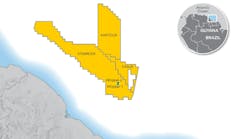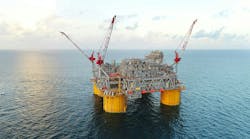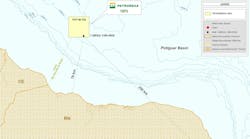In January we wrote that, on the heels of a strong showing at the first Gulf of Mexico lease sale since the Macondo incident, the outlook for the GoM was bullish. Indeed, the pace of new well permits is improving. From Feb. 28, 2011 (date of first new well permit in greater than 500 ft water depth) to Feb. 27 of this year, 61 new well permits were approved. During the same time period from Feb. 28, 2009, 67 new well permits were approved in corresponding water depth. Another positive indicator is rigs are returning to the Gulf. Pending unexpected delays, the expectation is that deepwater drilling will return to pre-Macondo levels by 2013.
And the backlog of field development projects is growing. Through 2014, nearly two dozen deepwater and ultra deepwater development projects are scheduled to come onstream.
Meanwhile, new acreage in the Gulf is available. The US and Mexico recently signed an agreement that establishes a framework for the countries to jointly develop the transboundary's reservoirs which are estimated to hold as much as 172 MMbbl of oil and 304 bcf of natural gas. In this issue,special correspondent Jerry Greenberg gets exclusive perspective from Johnna Van Keuren, Shell's vice president, HS&E, Exploration and Commercial, Upstream Americas, on the evolution of well permitting in the Gulf and how the operator is responding to the changes. Greenberg also reviews shelf drilling trends and deepwater developments in his special report beginning on page 34.
Emerging wet tree trends
Subsea capex is set to reach record highs over the next five years as facilities using wet trees have become the preferred deepwater Gulf of Mexico development option, according toMolly Reyes, Wood Mackenzie. During 2012-2016, Wood Mackenzie expects $14.2 billion to be spent on subsea capex in the region, with the majority targeting large fields with complex reservoirs in ultra deepwater. In this issue, Reyes discusses the shift to wet tree facilities and the outlook for subsea activity in the deepwater GoM. Her detailed report begins on page 108.
Mooring, riser solutions
As part of concept screening/appraisal of new GoM deepwater fields, BP retained SBMOffshore to evaluate existing disconnectable FPSO options with a focus on the vessel turret, the disconnectable system, and potential riser solutions. The study was based on a typical deepwater prospect in the western GoM. The field assumptions are that the development would be comprised of 12 subsea wells in 6,200 ft of water. Philippe Lavagna, SBMOffshore, summarizes the concepts that were evaluated and findings of the study, beginning on page 90.
Offshore Asia winners
Each year, the advisory board ofOffshore Asia Conference & Exhibition selects the best presenters from the technical sessions. Following are the recipients of the Offshore Asia 2012 awards:
- Young Engineer Award:Dr. Haibo Chen, Lloyd's Register Scandpower Collision and Oil Spill Risks in DP Shuttle Tanker Direct
- E&P Track Presentation Award:Robert Ziegler, Petronas Carigali A Concept of Drilling Deepwater Wells with Riser Margin and a Great Simplified Well Design
- LNG Track Presentation Award:John Sheffield, John M Campbell & Co. Liquefaction Technology for FLNG Applications
Congratulations. And thank you to all of the sponsors, delegates, exhibitors, and speakers for makingOffshore Asia Conference & Exhibition this past February a success. The event drew more than 3,600 attendees from 49 countries.
To respond to articles inOffshore, or to offer articles for publication, contact the editor by email ([email protected]).
Offshore Articles Archives
View Oil and Gas Articles on PennEnergy.com




